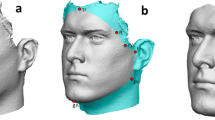Abstract
The paper describes a procedure aimed at identification from two-dimensional (2D) images (video-surveillance tapes, for example) by comparison with a three-dimensional (3D) facial model of a suspect. The application is intended to provide a tool which can help in analyzing compatibility or incompatibility between a criminal and a suspect’s facial traits. The authors apply the concept of “geometrically compatible images”. The idea is to use a scanner to reconstruct a 3D facial model of a suspect and to compare it to a frame extracted from the video-surveillance sequence which shows the face of the perpetrator. Repositioning and reorientation of the 3D model according to subject’s face framed in the crime scene photo are manually accomplished, after automatic resizing. Repositioning and reorientation are performed in correspondence of anthropometric landmarks, distinctive for that person and detected both on the 2D face and on the 3D model. In this way, the superimposition between the original two-dimensional facial image and the three-dimensional one is obtained and a judgment is formulated by an expert on the basis of the fit between the anatomical facial districts of the two subjects. The procedure reduces the influence of face orientation and may be a useful tool in identification.






Similar content being viewed by others
References
De Angelis D, Sala R, Cantatore A, Poppa P, Dufour M, Grandi M, Cattaneo C (2007) A new method for height estimation from images. Intl J Legal Med 121:489–492
Ventura F, Zacheo A, Ventura A, Pala A (2004) Computerized anthropometric analysis of images: case report. Forensic Sci Int 146S:S211–S213
Kleinberg KF, Vanezis P, Burton AM (2007) Failure of anthropometry as a facial identification technique using high-quality photographs. J Forensic Sci 52:44, 779–783
Halberstein RA (2001) The application of anthropometric indices in forensic photography: three case studies. J Forensic Sci 6(46):1438–1441
Lu X, Jain AK, Colbry D (2006) Matching 2.5D face scan to 3D models. IEEE Trans Pattern Anal Mach Intell 28:31
Vanezis P, Brierley C (1996) Facial image comparison of crime suspects using video superimposition. Sci Justice 36:27–33
Kleinberg KF, Vanezis P, Burton AM (2007) Failure of anthropometry as a facial identification technique using high quality photographs. J Forensic Sci 52(4):779–783
Yoshino M, Matsuda H, Kubota S, Imaitsumi K, Myhasaka S (2001) Computer-assisted facial image identification system. Forensic Sci Commun 3:53–59
Yoshino M, Noguchi K, Atsuchi M, Kubota S, Imaizumi K, Thomas CDL, Clement JG (2002) Individual identification of disguised faces by morphological matching. Forensic Sci Int 127:97–103
Goos MIM, Alberink IB, Ruifrok ACC (2006) 2D/3D image (facial) comparison using camera matching. Forensic Sci Int 163:10–17
Cattaneo C (2007) Forensic anthropology: developments of a classical discipline in the new millennium. Forensic Sci Int 165:185–193
Brinkmann B (2007) Forensic anthropology. Int J Legal Med 121:431–432
Introna F Jr, La Sala L, Mastronardi G (1992) Identificazione personale di soggetti viventi mediante elaborazione elettronica e confronto computerizzato delle immagini registrate su supporto magnetico (videotapes). Riv It Med Leg XIV:515–526
Sala R, Cantatore A, Cigada A, Zappa E (2004) Personal identification and minimum requirements on image metrological features. Proceedings of IMEKO, IEEE, SICE, 2nd International Symposium on Measurement, Analysis and Modeling of Human Functions, 1st Mediterranean Conference on Measurement, June 14–16, Genova, Italy
Author information
Authors and Affiliations
Corresponding author
Rights and permissions
About this article
Cite this article
De Angelis, D., Sala, R., Cantatore, A. et al. A new computer-assisted technique to aid personal identification. Int J Legal Med 123, 351–356 (2009). https://doi.org/10.1007/s00414-008-0311-x
Received:
Accepted:
Published:
Issue Date:
DOI: https://doi.org/10.1007/s00414-008-0311-x




